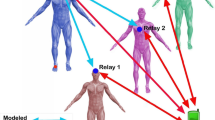Abstract
In this article, we propose and study the performance of low-power impulse radio ultra-wideband correlation-based time-of-arrival (TOA) estimators for body area networks. In particular, we study and compare the signal-to-noise-ratio degradation of TOA correlator-based estimators assuming optimal, real and complex suboptimal sinusoidal templates. Moreover, we study the improved Ziv-Zakai lower bound for complex suboptimal-template based TOA estimators. Then, we study and compare the performance of practical correlator-based TOA estimators using optimal, real and complex suboptimal sinusoidal templates via simulations in the IEEE 802.15.6a UWB on-body channel model as well as actual on-body measurements. The performance of real suboptimal template-based estimators approaches the performance of optimal TOA estimators based on simulations and actual measurements. We show that low-power is traded for a minimal performance loss.










Similar content being viewed by others
Notes
Mobile and Portable Radio Research Group at Virginia Tech.
References
Bindra, A. (2008). Medical info-communications signals an era of body area networking. RF Design, 10–14.
Zahng, J., Abhayapala, T. D., & Kennedy, R. A. (2005). Role of pulses in ultra wideband systems. In Proceeding of 2005 IEEE international conference on ultra-wideband, 2005. ICU 2005 (pp. 565–570).
Verhelst, M., Vereecken, W., Steyaert, M., & Dehaene W. (2004). Architectures for low power ultra-wideband radio receivers in the 3.1-5Ghz band for data rates < 10 Mbps. In Proceedings of the 2004 international symposium on low power electronics and design, 2004. ISLPED ’04. (pp. 280–285), August 9–11, 2004.
Sangyoub, L. (2002). Design and analysis of ultra-wide bandwidth impulse radio receiver. Ph.D. dissertation, Southern California University.
Ryckaert, J., Verhelst, M., Badaroglu, M., DAmico, S., De Heyn, V., Desset, C., et al. (2007). A CMOS ultra-wideband receiver for low data-rate communication. IEEE Journal of Solid-State Circuits, 42(1), 2515–2525.
Shaban, H. A., El-Nasr, M. A., & Buehrer, R. M. (2010). Toward a highly accurate ambulatory system for clinical gait analysis via UWB radios. IEEE Transactions on Information Technology in Biomedicine, 14(2), 284–291.
Shaban, H., Abou El-Nasr, M., & Buehrer, R. M. (2009). Performance of ultralow-power IR-UWB correlator receivers for highly accurate wearable human locomotion tracking and gait analysis systems. In IEEE global telecommunications conference, 2009. GLOBECOM 2009, November 30–December 4, pp. 1–6.
Verhelst, M., Dehaene, W., Shaban, H., Abou El-Nasr, M., & Buehrer R. M. (2008). Analysis of the QAC IR-UWB receiver for low energy, low data-rate communication. IEEE Transactions on Circuits and Systems I: Regular Papers, 55(8), 2423–2432.
Chung, W. C., & Ha, D. (2003). An accurate ultra wideband (UWB) ranging for precision asset location. 2003 IEEE conference on ultra wideband systems and technologies, pp. 389–393.
Dardari, D., Chong, C.-C., & Win, M. Z. (2006). Improved lower bounds on time-of-arrival estimation error in realistic UWB channels. The 2006 IEEE 2006 international conference on ultra-wideband, pp. 531–537.
Falsi, C., Dardari, D., Mucchi, L., & Win, M. Z. (2006). Time of arrival estimation for UWB localizers in realistic environments. EURASIP Journal on Applied Signal Processing, 2006, 152–152.
Acknowledgments
The authors would like to thank Haris Volos, former Ph.D. candidate at Wireless @ Virginia Tech research group, for taking the UWB measurements.
Author information
Authors and Affiliations
Corresponding author
Rights and permissions
About this article
Cite this article
Abou El-Nasr, M., Shaban, H.A. & Buehrer, R.M. Low-power IR-UWB coherent TOA estimators with suboptimal sinusoidal templates for UWB-based body area networks. Wireless Netw 17, 1641–1648 (2011). https://doi.org/10.1007/s11276-011-0369-0
Published:
Issue Date:
DOI: https://doi.org/10.1007/s11276-011-0369-0




